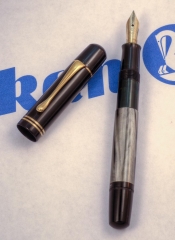I’ve become subterranean. I’m not a bat yet but I’ve moved all my pen repair tools, parts, and various oddities down to my basement. Combine that with a desk, shelves, lights, and a chair and I’ve created what I now call a pen cave. The reason for this was more than just getting all this out of my home office to a larger area but a step to be more professional since I plan to start offering my repair services for a fee. So from now on I’ll be generating posts from the dark pen cave and having Alfred bring me some snacks while I do so. OK, there’s no Alfred and no pole I can slide down and be garbed in a fancy outfit but it’s the same idea.
The subject of this post is a well-known and not uncommon pen from Germany: The Pelikan 100N. Why I’m addressing this model is that I’d like to point out is how happy I am when a pen is designed so well as to be a pleasure to work on. Germans often have the reputation as meticulous mavens of over-engineering and are the subject of oft told stories like the one about the far too numerous components of the lowly ashtray in vintage Mercedes. Still, often they make elegant and simple designs. The pen I’m discussing today is an example of such and possibly that’s one reason why it was produced for so long and became so popular.
I’m a sucker for classic design and the Pelikan 100N is a prime example. I love the celluloid barrel sleeve’s contrast to the ebonite parts along with the proportions of cap and body. Its squared off look seems just so right for something from the golden era of fountain pens. Overall I think anyone could see it’s an unassuming, refined design that quietly proclaims good taste.
It’s under the exterior where this pen shines to me the most. Teutonic manufacturers have been and continue to be the Rock of Gibraltar for piston mechanisms having popularized and improved that means of filling for many years. There’s good reason for sticking by it since it’s a reliable, efficient, and satisfying way to move writing liquid into your pen. The downsides are that there are methods with greater ink capacity, fewer moving parts, and lower cost. Whatever drawbacks you come up with no other filling method can capture the exquisite feel of watch-like precision you get from twisting the piston knob slowly and smoothly when the pen is submerged in an ink bottle.
How piston fillers work is simple enough that anyone can understand from the briefest of outlines: The barrel of a pen is a tube and if the end of that tube is moved upwards expanding the empty space inside you get negative pressure. If you create that void while the end of the tube (with nib and feed attached) is in ink then ink is drawn in. Nature abhors a vacuum and so does a fountain pen. Even the specific parts are very simple in this system since basically all you need is a seal which acts as the air-tight end of inner barrel, a long rod like screw inside an internally threaded shaft which the seal attaches to, a fixed end collar which keeps the shaft straight so it goes up down when turned by a knob attached to the screw.

If you look at the picture of the disassembled Pelikan 101N above you see the aforementioned parts and a few others which make the pen a pen and not just a piston. What warms my heart about this vintage pre-war design is the excellent engineering. There is only the minimum number of parts needed to make this pen work well. No fancy or illogical bits thrown in much like how the pen’s appearance forswears the gaudy. All of the pieces come apart easily (as easily as they could on a pen over a half century old) and fit back together with no fuss. The piston seal snaps onto the end of the rod without needing any form of fastening using the elasticity of the material to hold it on like a bottle top. I can take this pen to pieces and have it back together in seconds which makes me feel a bit like a fictitious action hero who can field strip and reassemble his weapon blindfolded in minutes. The successor line to the 100N (400/400N/400NN) replaced this screw in piston with a friction fit one (which continues today on the lower end Pelikans) and while still a fine pen I’m not quite enamored of that change which makes repair more difficult.
Of course if the pen didn’t work well then all I’ve said would be much ado about nothing but it does. This should not be a surprise since the ink delivery and transfer mechanism here reflects the refinements of the 70 odd prior years of fountain pen making. The open nib and finned hard rubber feed with dual fissures are conservative and well proven to do the job. Pelikan nibs are known to be high quality units that have always been shaped and ground well so no problem there. Probably the large green ink window is the showiest bit of this pen but also extremely useful and welcome. All in all if not an exciting pen to use one that won’t let you down.
If I were asked what classic fountain pen someone should get first based on price, quality, and design I would be hard pressed to think of anything better than a Pelikan 100N. While not flashy it is one of the jewels in fountain pen history.








